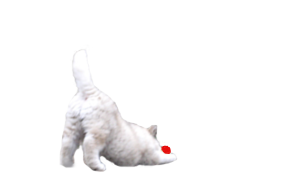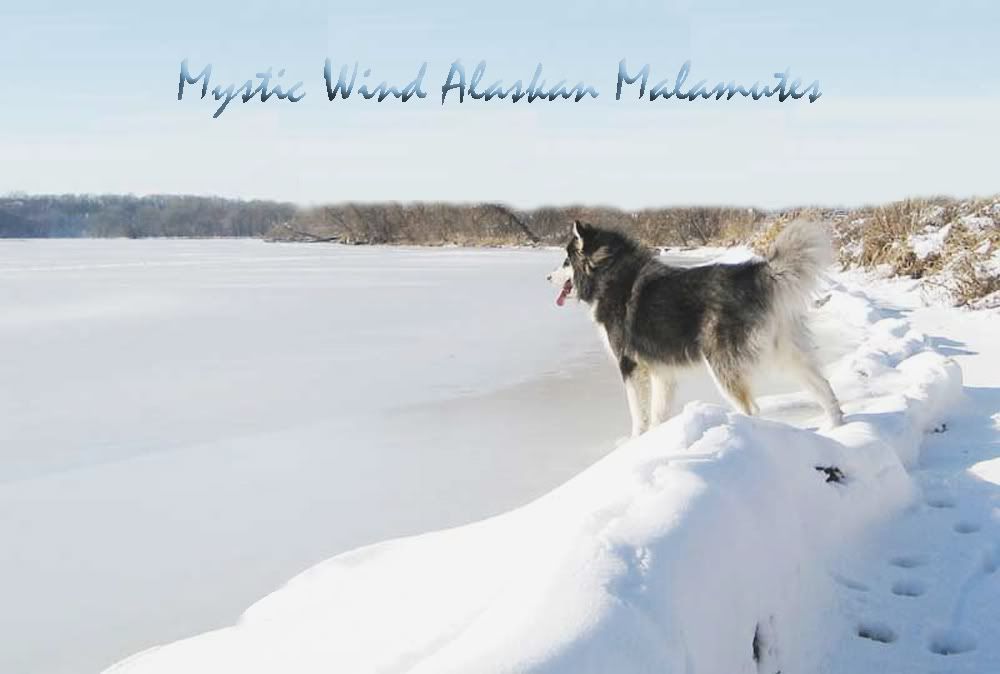
Reserve an area of the yard for your Malamute to dig in. Praise him when he digs in the allowed area.
Build a large sand box for a your Malamute to dig in.
Teach your dog the word "dig". Teach your Malamute to dig only in desired areas by burying a treat just a few inches under the dirt, as he watches. Release him to get the treat and say "Dig!". Praise him as he digs. Bury the treat a little deeper each time and move your dog further away each time. Eventually, have your dog across the yard and say, "dig!" as you release him to go find the treat. Once he has this down, you can take the training a step further by burying the treat when the dog can not see you. Put him in the house or the car on the other side of the house while you bury it.
BARKING/HOWLING:
Get creative, hide on the roof of your house. Buy an adapter for the kitchen sink and sit below a window in the house and squirt him from that angle. Training fails 90% of the time because your technique is not creative. You get back what you put in. So, if you take an hour out of your day to get the hose & yourself on to the roof of your house and surprise the day lights out of your dog when he barks, then it should only take a few days to completely rid your dog of barking forever.
However, if you stick your head out of the window and yell "quiet" each time he barks, I am willing to bet money that you will never rid your dog of barking. In fact, you will probably make it worse.
Remember: Bad attention is ALWAYS better then no attention.
For barking/howling in the crate indoors all night while you are trying to sleep, a spray bottle of vinegar works. This is only acceptable for dogs or older puppies (over 6 months) who should have been sleeping through the night long ago or are being rebellious. Do not use this method on innocent puppies who are lonely and do not know any better.
Each time the dog yips spray his nose with a short burst and be very careful not to get it in his eyes! While it is harmless, it stings so please take care not to spray it towards the eyes and turn the nozzle setting to 'stream' rather then 'mist' and direct it at the end of his nose. Even if it doesn't hit his nose, the sour smell in the air going past it should do the trick.
FOOD OBSESSION:
The solution: Your Malamute should ALWAYS earn his dinner! From the time your Alaskan Malamute is a small pup, make him sit and stay while you scoop out and carry his food to the dining spot. This exercise is a great head start for the stay command. Never skip this ritual. Even if you are rushed, make him sit & stay for 3 seconds at the very least.
HOW TO:
I can not stress how important this feeding ritual is. I have a friend who broke her hip and coudln't walk for 3 months because her 100 pound Alaskan Malamute decided, "I'm taking MY food right NOW!". Remember, it is YOUR food. You bought it. He must earn it too.
STEALING FOOD/TRASH DIGGING:
As far as trash digging goes, hide a 'trap' that will spring out and make a lot of racket in the garbage can when he tips it or opens the lid. For house garbage cans, simply keep it under the sink, in the kitchen closet, or behind a door of some sort.
Buy a large garbage can and hide in it yourself, jumping out & screaming & waving your arms like you are insane when your dog comes near- this does the trick permanently on the first try, although it may only work for the very large, out door garbage cans. Unless you are a very small, Asian women.
NEVER give your dog chicken, turkey, or any other bird bones.
The best bones for Alaskan Malamutes are authentic cow leg & knuckle bones from your butcher shop. If that is not convenient, many farm supply stores carry (such as Fleet Farm) the dehydrated versions of these. The ones with the dried blood and skin still attached. I have noticed recently that major chain pet stores, such as Petsmart & Petco, are also carrying them but for literally double the price.
A side note: A farm supply store is a great place for a "watering trough" for your Malamute in the summer months. This ensures you do not have to refill the bowl every hour, or worry about whether or not your dog has enough water while you you are away from home.
If you provide enough toys and cow bones, you should have no problem with chewing. Always kennel or crate your Malamute when you are away from home and if he is under 2 years old.
Kong's, or any toy with holes, can be filled with cheez wiz as a much (much!) cheaper alternative to "kong stuffin'".
If there is a particular item your dog is determined to chew on, your pet store carries a product called "Bitter Apple", in a spray bottle. This product is safe for just about anything. Simply spray it on.
DOMINANCE:
AGRRESSION:
A Side Note:
My whole point is, don't let anyone make you feel bad, or like you have a bad Mal just because he/or she may be doing what so many do, or because you got an odler dog who was not socialized properly!
STUBBORNESS/REBELLION:
The hose works wonderfully for this. Make sure you are well hidden and don't say a word. Use a sprayer attachment. Use a quick, short burst of water at his feet or on his hind end and try not to let him see you. This way the dog thinks the water is coming out of no where, and is liable to do so at any time. If the dog sees you, he will learn to make noise when you are away from home, which could be worse. This will get you in trouble with the neighbors!
This is why it is so important to stay hidden.
Also, if you can hide, all the better. Spend 15-25 minutes the first few nights hiding behind the couch with the spray bottle. Wait for the dog to start in and then jump out and squirt his nose. Don't say a word and retreat back to your hiding place as quickly as possible. Switch hiding locations each night. After the second or third night, the dog no longer howls in his crate.

Alaskan Malamutes are nuts about their food and may knock you down or injure you during feeding time. Your cute little puppy will become a savage wolf as he grows older and bigger, and will completely dominate you for a chance at getting that kibble just seconds sooner then he would if he waits for you to set it down. Nip this behavior in the bud. Begin teaching self control from the time your puppy first comes home
Set his food down and hold your hand out, palm facing him, push your hand forward (like you would to give the "stop" command while crossing the street) and say "stay". Stand right by his bowl on the ground and make him stay where he is until you say "OK" and release him to come eat. If your dog begins to stand up or break his 'stay' grab him and put him back in place repeating "stay" as your palm goes to his face. Gradually increase the time as well as the distance between you and the food bowl. Be ready to act fast- the further you move from his bowl, the quicker you will need to be if he decides to break the command. Anytime he breaks the 'stay' command before you release him, you MUST make it to the dog to stop him BEFORE he gets a single kibble on his palette. If he does sneak a kibble, or a mouthful, take it back. If at all possible, open his mouth and let it drop back out or scoop it out with your hand saying "No!" and walk him back to his original position and start over.
I recommend never giving your dog a chance to steal food. Attempting to train your dog to be left alone with a ham sand which is an extreme form of training and generally only performed with working service dogs.
If you have a timid or shy dog- a dog who may potentially become traumatized, do not attempt this method. When you jump out of that trash can your dog is going to be scared silly. It is the absolute LAST thing he would ever expect.

CHEWING:
Provide plenty of real bones for your dog to chew on. Common sense here.
Most Malamutes are dominant by nature. This should never be confused with aggression. A dominant dog simply tries to use his weight to push you around or may bark in a very demanding tone with you (and you will know when you hear it) to "hurry up", but will not bite or attack you. Most often, dominance is displayed through play. I never wrestle with a dog I know will grow up to be stronger then me. If you do it as a puppy, he will get bigger and learn he is top dog. Alpha rule are put in place with dominant dogs. Ask your breeder what pack rank your puppy held in the litter. A dog who is out of control and insists on jumping up to knock you down, stealing food out your hands or knocking you over to get it, and so on, should be made to watch you eat your meal before he gets his, should go through all doors and doorways last (preferably should "sit" to earn going through a doorway), and in extreme dominance cases, sit on him for 5 minutes day. To be continued...
Malamutes are in no way people aggressive. Quite the contrary! However, Malamutes are known to be aggressive towards same sex dogs, and sometimes even the opposite one. Well known for this. So it's not just your dog. Socialization in puppy hood makes a huge difference (and I mean every other day at a dog park or training classes with a lot of dogs for the 1st year). If your dog becomes a danger to other dogs, I would recommend keeping the them separated with baby gates and working with the aggressor slowly, and muzzled with a basket muzzle on. A dog trainer is a great idea if you are new to Malamutes and/ or dogs. However, most likely, a dog trainer isn't going to be able to "permanently" solve this problem and your Mal could be in a bad mood on any given day for any given reason and snap at another dog, even if she hasn't done so in a long time. A Malamute who has proved she likes to fight, usually doesn't stop or "mellow out", except in the case of adolescence coming and going. Teenagers are more aggressive and tend to settle down after age 2 or 3 and after establishing a pack order. And I don't want to say anything that could get you hurt so use EXTREME caution with this, but generally you can break a malamute fight up with your hands without getting bit because Mals either don't like to bite humans or they are just weird that way, but either way when hands and arms come into the middle he normally halts aggression or at least if he does keep lunging at the other dog, he's *usually* sure not to bite you.
A lot of ritzy-image-is-everything kennels will have you believe optimum breeding, spending a ton of money on a malamute from a show kennel, and temperament, have a lot to do with fighting (and that their dogs never fight) It DOESN'T. Pack order does. I've been to many dog shows and met many sled dogs of the Malamute breed and seen equal amounts of aggression. I've seen women frantically distract their dogs to keep them from growling at the one next to them in the show ring and brag all over their website about how great their dogs' temperaments are and how only dogs with these superior temperaments should be bred... knowing full well that their dogs are just as capable as showing same sex aggression as anybodies, and they are breeding them. I've even had dogs from these kennels, one from a world renowned show kennel near where we lived in Wisconsin, snarl at me and another passerby just for coming near his crate! This dog went on to win his championship and was bred over and over as being a top specimen of his breed. A lot of these breeders are so self obsessed with their image that they live in a fantasy land that even they have begun to believe exists. This is certainly not to say all Malamutes are fighters! Many are NOT. But many ARE. And like I mentioned, well socialized pups stand the best chance at not becoming fighters. The only time my Malamutes fight is when one goes into heat. Otherwise they are all loose together in the dog pen. In some cases, such as a bad tangle ont eh trail, might set a dog fight into motion because a dog feels his personal space is being invaded or he feels trapepd. Every kennel is different. And while it is just plain stupidity to breed 2 aggresive dogs together, a Malamute does not neccessarily have a bad temeperament just because there is an occassional scuffle within the pack.































